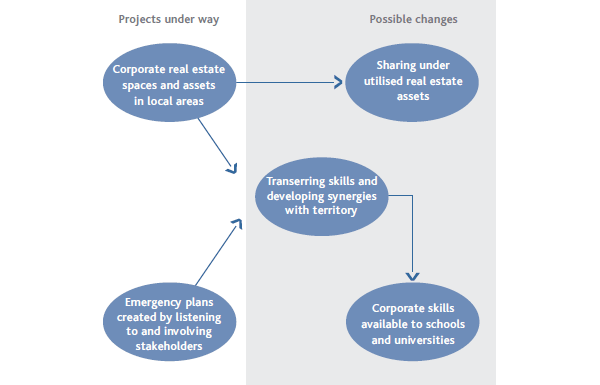The process of managing sites and, in general, all of the Company’s assets involves all of the activities associated with managing the group’s infrastructure in order to ensure that it is maintained and used in accordance with the quality standards defined by Snam and regulatory requirements. Real estate asset management and general services are defined as “non-core” by Snam. The asset management process includes managing compression and storage stations and treatment facilities, transportation and distribution lines, regasification plants, storage wells and metering facilities. Snam is capable of generating shared value alongside this process when the management of infrastructure and real estate assets takes place while at the same time increasing corporate citizenship locally.
SITE AND INFRASTRUCTURE MANAGEMENT – SUMMARY CHART

In terms of safety, the best practice represented by the evacuation plan outside the Panigaglia regasification plant is noteworthy. This procedure, which is mandatory pursuant to Legislative Decree 334/1994 on major incident risks, has been drafted and shared over the years with local institutions. At the time of the flood that hit the area of Lunigiana in 2010, the plant’s emergency plan was used to manage the evacuation, supporting rescue coordination and representing a case of excellence. Snam is now evaluating areas for potential cooperation with local players in order to share skills and best practices and to develop synergies aimed at the planning and governance of some aspects specific to local areas.
An additional area in which the potential for generating present and future shared value is significant is that of making real estate spaces and assets available to local areas. In particular, GNL Italia is already a positive reference in the sharing of corporate spaces with the example of Ca’ Bertocchi, a fully renovated period villa owned by it and made available to the local community for cultural events, conferences, etc.
An interesting opportunity is afforded by maximising the potential of unused spaces in cooperation with local authorities or non-profit associations operating in the local areas where the Company is present. Snam may make equipped areas neighbouring its plants available to interested citizens. Such areas, which are appropriately regulated, may be intended for varied uses (e.g. the planting of small vegetable gardens turned over to the community). Furthermore, the plants are already places for increasing biodiversity, ecosystems where different species have become established: Snam will evaluate the possibility of entering into agreements with specialised partners to encourage the study and protection of fauna, and possibly also with academic institutions interested in educational courses on the wealth of local fauna.

These activities could be included in broader projects aimed at making the Company’s innate knowledge and skills available to schools, which would also help improve the link between the academic world and the world of work, in order to afford young people full awareness of the Italian corporate and industrial world, of which Snam is a leading proponent. Improved knowledge and skills among candidates for a possible recruiting pool is also an implicit advantage for the Company. Sharing corporate excellence may also be considered with university and post-graduate training centres by implementing partnerships with training institutions. Specifically, a dialogue could be implemented with universities on such topics as workplace safety, asset security, technological research and development, the crowning achievements of the group’s savoir faire. Lastly, again in cooperation with university centres, Snam may consider sharing its skills to support the start-up and subsequent development of innovative companies possibly compatible with its own sector. This assistance could be articulated around different topics, from developing a business model to building a partnership and from access to qualified professionals to the search for capital.
The benefits of the stock of local capital are evident and encompass all four of the areas of application of the model: economic, social, human and natural.



